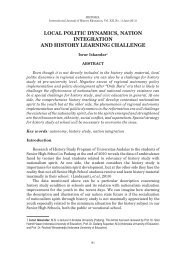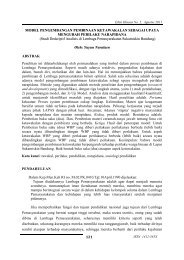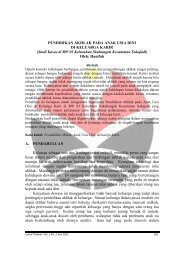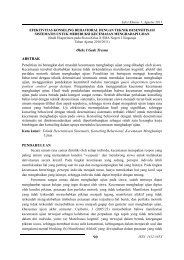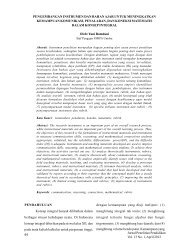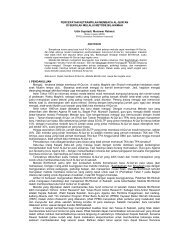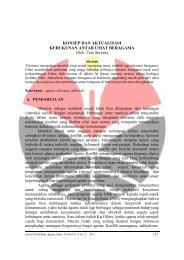a descriptive study on the teacher talk at eyl classroom - Jurnal UPI
a descriptive study on the teacher talk at eyl classroom - Jurnal UPI
a descriptive study on the teacher talk at eyl classroom - Jurnal UPI
You also want an ePaper? Increase the reach of your titles
YUMPU automatically turns print PDFs into web optimized ePapers that Google loves.
CONAPLIN JOURNAL<br />
Ind<strong>on</strong>esian Journal of Applied Linguistics, Vol. 1 No. 2 (January 2012)<br />
@The Author(s) 2012<br />
Table 1 - Target Language Observ<strong>at</strong>i<strong>on</strong> Scheme of <strong>the</strong> Participants (In Percentage)<br />
Descripti<strong>on</strong> 0 1 2 3 4<br />
01. Use of language 1 100<br />
02. Use of language 2 0<br />
03. Teacher Talk Time 33 67<br />
04. Explicit less<strong>on</strong> structure 33 67<br />
05. Task orient<strong>at</strong>i<strong>on</strong> 100<br />
06. Clarity 33 67<br />
07. Initi<strong>at</strong>e problem solving 33 67<br />
08. Pers<strong>on</strong>alized questi<strong>on</strong>s and comments 0<br />
09. Positive reinforcement 100<br />
10. Neg<strong>at</strong>ive reinforcement 33 67<br />
11. Correcti<strong>on</strong>s 33 67<br />
12. Pacing 67 33<br />
13. Use of audio-visual aids 100<br />
14. Gestures 33 67<br />
15. Humour 33 67<br />
16. Enthusiasm 50 50<br />
The table above shows th<strong>at</strong> most of <strong>the</strong> <strong>teacher</strong>s use English 100% since <strong>the</strong>y are real n<strong>at</strong>ive<br />
speakers, which encourages students to <strong>talk</strong> in <strong>the</strong> target language. The use of sec<strong>on</strong>d<br />
language, th<strong>at</strong> is Ind<strong>on</strong>esian, for those three n<strong>at</strong>ive speakers, is null percent since <strong>the</strong>y are not<br />
allowed to <strong>talk</strong> in Ind<strong>on</strong>esian within <strong>the</strong> school envir<strong>on</strong>ment. This situ<strong>at</strong>i<strong>on</strong> is very beneficial<br />
for young learners to acquire <strong>the</strong> target language autom<strong>at</strong>ically because <strong>the</strong>y use and are faced<br />
to <strong>the</strong> target language most of <strong>the</strong> time. The use of audio-visual is very high too, th<strong>at</strong> is 100%.<br />
This shows th<strong>at</strong> <strong>the</strong> three <strong>teacher</strong>s have already been able to make use of <strong>the</strong> technology skills.<br />
Gestures and humour are also employed in class to support <strong>the</strong> teaching-learning situ<strong>at</strong>i<strong>on</strong><br />
(67%). Most of <strong>the</strong> TTT used in class is so high. This is in line with Ellis (1985 p. 43) saying<br />
th<strong>at</strong> successful outcomes may depend <strong>on</strong> <strong>the</strong> type of language used by <strong>the</strong> <strong>teacher</strong> and <strong>the</strong> type<br />
of interacti<strong>on</strong>s occurring in <strong>classroom</strong>. Specifically for Ind<strong>on</strong>esian young learners, where <strong>the</strong><br />
circumstance outside <strong>the</strong> class doesn‟t support <strong>the</strong>m to use <strong>the</strong> target language in daily<br />
c<strong>on</strong>vers<strong>at</strong>i<strong>on</strong>, class becomes an ideal place for <strong>the</strong>m to learn English since it allows <strong>the</strong>m to be<br />
in c<strong>on</strong>tinuous c<strong>on</strong>tact with <strong>the</strong> <strong>teacher</strong>s who speak in <strong>the</strong> target language, <strong>the</strong>refore TT should<br />
be employed very high. 67% (2 <strong>teacher</strong>s) also taught giving explicit less<strong>on</strong> structure, but <strong>on</strong>e<br />
<strong>teacher</strong> (33%), I noticed – failed since she lacked <strong>the</strong> ability for c<strong>on</strong>trolling <strong>the</strong> class. One<br />
<strong>teacher</strong> was very unclear, again, because she couldn‟t c<strong>on</strong>trol <strong>the</strong> class well. Her class was so<br />
noisy and <strong>the</strong> students <strong>talk</strong>ed by <strong>the</strong>mselves, ignored her instructi<strong>on</strong>s and gave not rel<strong>at</strong>ed<br />
comments. Doe to <strong>the</strong> positive reinforcement, <strong>the</strong> 3 <strong>teacher</strong>s (100%) got extremely high point<br />
– 4. It shows to us th<strong>at</strong> <strong>the</strong>y have already understood <strong>the</strong> importance of positive reinforcement<br />
to build up <strong>the</strong>ir learning motiv<strong>at</strong>i<strong>on</strong>. And 2 <strong>teacher</strong>s (67%) were successful to avoid using<br />
neg<strong>at</strong>ive reinforcement, while <strong>on</strong>e <strong>teacher</strong> (33%) failed avoiding using it since she thre<strong>at</strong>ened<br />
<strong>the</strong> class so many times when <strong>the</strong> students disobeyed her.<br />
39 | P a g e



